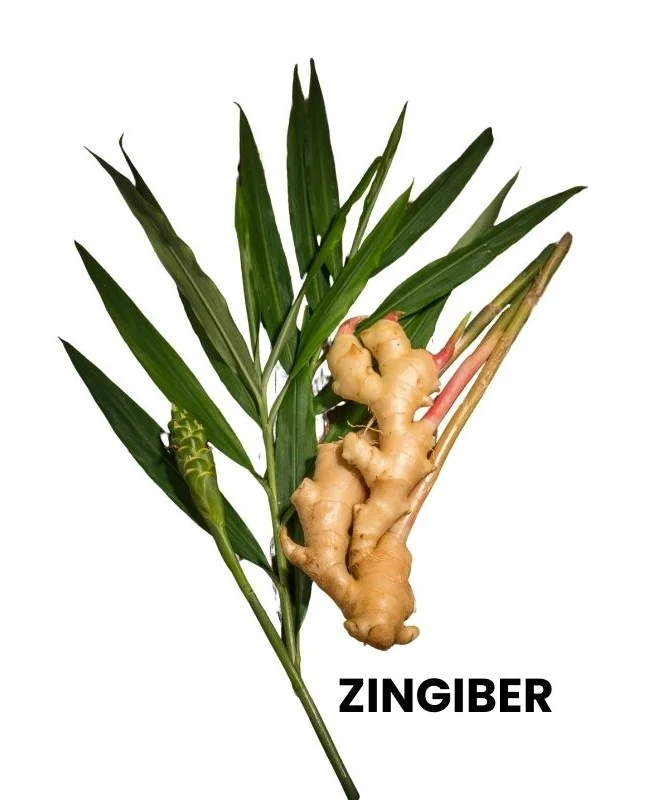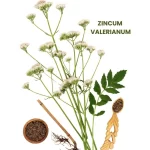Zingiber, commonly known as Ginger, is a homeopathic remedy derived from the rhizome of the ginger plant.
It is primarily used to address states of debility in the digestive tract, sexual system, and respiratory system.

Table of Contents
ToggleSOURCE INFORMATION
- Kingdom: Plantae
- Order: Zingiberales
- Family: Zingiberaceae
- Genus: Zingiber
- Species: Z. officinale
Origin
Zingiber officinale, commonly known as ginger, is a flowering plant native to Southeast Asia, where it has been cultivated for thousands of years.
It is believed to have originated in the Indian subcontinent and has since been widely cultivated in tropical and subtropical regions around the world.
- Ginger is a perennial herbaceous plant that belongs to the Zingiberaceae family.
- It grows up to about 1 meter in height and has long, green leaves arranged alternately along its stem.
- The rhizome, or underground stem, is the part of the plant most commonly used in cooking and medicine.
- The rhizome is knobby, beige, or pale yellow in color, and emits a distinct spicy aroma when cut or crushed.
- Ginger produces clusters of white or yellow flowers with purple markings, although it is primarily grown for its rhizomes rather than its flowers.
Cultivation
- Ginger requires a warm and humid climate to thrive and is typically grown in well-drained, fertile soil.
- It is propagated through rhizome cuttings and requires regular watering and mulching to retain moisture.
- The plant takes approximately 10 months to mature, at which point the rhizomes are harvested for consumption or processing.
Culinary and Medicinal Uses
- Ginger has been used for culinary and medicinal purposes for thousands of years.
- In cooking, ginger is prized for its unique flavor and aroma, which can range from spicy and pungent to mildly sweet.
- It is commonly used in various cuisines around the world, particularly in Asian and Indian cooking, to flavour dishes such as curries, stir-fries, and soups.
- Medicinally, ginger is known for its anti-inflammatory, antioxidant, and digestive properties.
- It is used to alleviate nausea, indigestion, and motion sickness, as well as to reduce inflammation and relieve pain associated with conditions such as arthritis and migraine headaches.
Interesting Facts
- Ginger has a long history of use in traditional medicine systems, including Ayurveda and Traditional Chinese Medicine (TCM).
- It was highly valued in ancient civilizations for its medicinal properties and was often traded along ancient spice routes.
- Ginger has been used to treat a wide range of ailments, including digestive disorders, respiratory infections, and inflammatory conditions.
- Today, ginger is widely available in various forms, including fresh, dried, powdered, and as a dietary supplement or herbal remedy.
DRUG PATHOGENESIS
Zingiber primarily affects the digestive tract, sexual system, and respiratory system.
It helps alleviate symptoms such as hemicrania, nasal obstruction, stomach heaviness, acidity, colic, diarrhea, urinary disturbances, sexual dysfunction, respiratory issues, weakness in joints, and back pain.
KEY CHARACTERISTICS
- Taste of food remains long, especially bread and toast.
- Complaints from eating melons and drinking impure water.
- Hoarseness and difficulty breathing.
- Dry hacking cough with copious morning sputa.
- Weakness in all joints and cramps in soles and palms.
PARTICULAR ORGAN SYMPTOMS
Head
- Hemicrania (one-sided headache) with sudden glimmering before the eyes suggests a migraine-like headache.
- The individual feels confused and empty, indicating mental fog or disorientation.
- Pain over the eyebrows can be indicative of tension or sinus headache.
Nose
- Feeling obstructed and dry suggests nasal congestion and dryness, possibly due to inflammation or irritation.
- Intolerable itching with red pimples may indicate allergic or inflammatory reactions in the nasal passages.
Stomach
- Taste of food remaining long, especially bread and toast, suggests slow digestion or acid reflux.
- Feeling heavy, like from a stone, may indicate bloating or indigestion.
- Complaints from eating melons and drinking impure water suggest food or waterborne illnesses.
- Acidity with heaviness in the stomach on awakening indicates gastric discomfort and acidity.
- Pain from the pit of the stomach to under the sternum, worsened by eating, suggests gastritis or acid reflux.
Abdomen
- Colic and diarrhea with extremely loose bowels suggest gastrointestinal upset or infection.
- Diarrhea from drinking bad water with flatulence and cutting pain indicates gastrointestinal infection or food poisoning.
- Hot, sore, and painful anus during pregnancy suggests hemorrhoids or anal discomfort.
- Chronic intestinal catarrh indicates inflammation of the intestinal lining.
- Red and inflamed anus with hot, painful, sore hemorrhoids suggests hemorrhoidal inflammation.
Urinary
- Frequent desire to urinate suggests urinary urgency.
- Stinging and burning in the urinary orifice may indicate urinary tract infection or irritation.
- Yellow discharge from the urethra suggests infection or inflammation.
- Thick, turbid urine with a strong odour suggests dehydration or urinary tract infection.
- Complete suppression of urine after typhoid indicates kidney dysfunction or dehydration.
Male
- Itching of the prepuce suggests irritation or infection of the foreskin.
- Sexual desire excited with painful erections suggests sexual arousal accompanied by discomfort.
- Emissions may indicate nocturnal emissions or involuntary ejaculation.
Respiratory
- Hoarseness suggests vocal cord inflammation or laryngitis.
- Smarting below the larynx with difficult breathing may indicate respiratory irritation or asthma.
- Asthma without anxiety, worse toward morning, suggests nocturnal asthma or early morning exacerbation.
- Scratching sensation in the throat with stitches in the chest suggests throat irritation and chest discomfort.
- Dry hacking cough with copious morning sputum may indicate respiratory infection or bronchitis.
Extremities
- Weakness in all joints suggests generalized fatigue or musculoskeletal weakness.
- Lame back indicates back pain or discomfort.
- Cramps in soles and palms suggest muscle spasms or dehydration.
REMEDY RELATIONSHIP
Compare with Calad., antidote with Nux.
DOSE
First to sixth potency.
Frequently Asked Questions
What conditions is Zingiber indicated for?
- Zingiber is indicated for states of debility in the digestive tract, sexual system, and respiratory system.
How should Zingiber be dosed?
- Zingiber is typically prescribed in potencies ranging from first to sixth.
Can Zingiber be used alongside other medications?
- Yes, Zingiber can generally be used alongside other medications.
However, it is advisable to consult a healthcare professional before combining it with other remedies.
Meaning of Difficult Words
- Rhizome: A continuously growing horizontal underground stem that puts out lateral shoots and adventitious roots at intervals.
- Hemicrania: A severe, usually one-sided headache.
- Asthma: A respiratory condition marked by attacks of spasm in the bronchi of the lungs, causing difficulty in breathing.













Leave a Reply